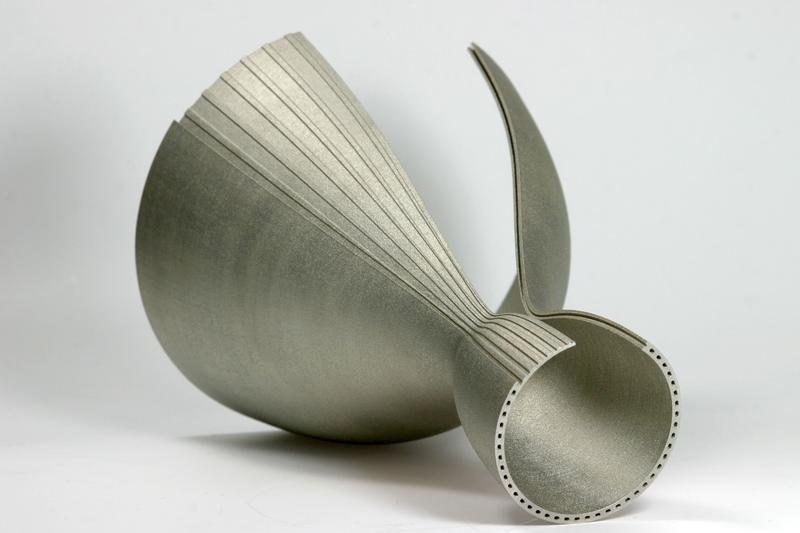

Rocket nozzle, additively manufactured by powder-bed technology, with adapted cooling channels
Fraunhofer IWS Dresden
The 3D-printing technology, or additive manufacturing as it is often called, has long made the step out of scientific research laboratories into industrial applications. For example, the fabrication of dental crowns or implants is just as much within the additive manufacturing application field as the printing of aircraft components is. This does not mean that the scientists may take a break, but rather exactly the opposite!
“The huge potential promised by additive manufacturing can only be utilized, if science and industry cooperate. Presently we are using only a fraction of the potential which process- and materials technologies offer”, explains Prof. Christoph Leyens, head of the AMCD. The materials scientist is a professor at TU Dresden and a director of the Fraunhofer IWS.
A research team headed by Prof. Leyens coordinates the huge international research project “AGENT-3D“. This project brings together more than 100 industrial and scientific partners, who work hand in hand on solutions related to the implementation of additive manufacturing into industrial applications.
The German Federal Ministry of Education and Research has funded the project with 45 million euros. In addition, the involved industrial companies have supported the research project with about 30 million euros. Furthermore our IWS and TU scientists are working full steam on further research projects and industrial cooperations, since the international competition to find best product solutions is really strong.
Prof. Eckhard Beyer, the executive director of the Fraunhofer IWS and a professor for Laser- and Surface Technology at TU Dresden, emphasizes the significance of the research with respect to additive manufacturing in Dresden: “Scientists join the AMCD to develop future manufacturing technologies. Our primary objective is the development of industrially mature solutions and thus to strengthen the innovative and economical capability of our partners.”
The AMCD ranks among the largest centers of its kind in Europe. It has been supported by means of the Fraunhofer-Gesellschaft and the Free State of Saxony. The center offers the most important and industrially relevant manufacturing technologies for metals, ceramics and plastics. Its unique feature is the comprehensive expertise of all involved scientists with respect to process- and material know-how. Only the combination of process development and material expertise enables the production of innovative 3D-printing products, which are cost-effective and reliable as well.
For example, a rocket nozzle (Fig. 1) developed for the space industry must resist the highest loads during operation. During the additive manufacturing of the nozzle even the smallest defects or cracks have to be avoided, since they would lead to the complete rejection of the part. Our AMCD laboratories offer comprehensive techniques for non-destructive or load tests in order to detect defects or to test materials. The AMCD unites the excellent basic research expertise of TU Dresden with the comprehensive IWS application-oriented research under one roof.
“The establishment of the Center for Additive Manufacturing Dresden has an outstanding relevance for Saxony, explains Dr. Fritz Jaeckel, Minister of State, in his speech. Cutting-edge research and the development of innovative technologies are the most important prerequisites for the positive development of our Free State, our society and our companies“. Prof. Gerhard Rödel, Vice Rector of the TU Dresden highlights the enormous significance of the cooperation between the university and Fraunhofer IWS: “With the foundation of the AMCD it becomes widely visible how our research alliance DRESDEN-concept works: namely, by scientific cooperation and networking of our greatest minds.” DRESDEN-concept is an alliance of TU Dresden and non-university research partners in Dresden. It was an important element for the successful application of TU Dresden as an Excellence University.
The inauguration of the AMCD took place on the eve of the 2nd International Symposium Additive Manufacturing, being held at the International Congress Center Dresden on February 8 – 9, 2017. Invited by the Fraunhofer IWS Dresden, more than 250 experts in the field of 3D printing meet to discuss the latest developments in this rapidly advancing research field. All participants will be actively involved in discussions by means of a “World Café” – a kind of speed dating for scientists. Here, they are invited to exchange their experiences in research and application in small groups with changing discussion partners.
Contact:
Fraunhofer-Institut Werkstoff- und Strahltechnik IWS Dresden
Winterbergstr. 28, 01277 Dresden
Prof. Christoph Leyens
Phone: +49 351 83391-3242
Fax: +49 351 83391-3300
E-Mail: christoph.leyens@iws.fraunhofer.de
Public Relations
Dipl.-Ing. Virginie Garten
Phone: +49 351 83391-3336
Fax: +49 351 83391-3300
E-Mail: virginie.garten@iws.fraunhofer.de
Internet:
http://www.iws.fraunhofer.de and
http://www.iws.fraunhofer.de/en/pressandmedia/press_releases.html
http://www.isam.network
http://www.iws.fraunhofer.de/en/centers/additive_manufacturing.html












